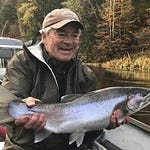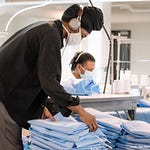Some context for today’s conversation, since this is a space where both the technology and terminology are evolving:
Direct air capture [DAC] is an emerging technology that we want to differentiate from the more controversial point source carbon capture, which targets CO2 from power plants and other sources of concentrated emissions but can justify the prolonged use of fossil fuels, among other concerns. Ryan clarifies: “There are some new projects looking to use DAC CO2 for industrial processes in the oil and gas sector which have received criticism for the same reason, but generally speaking DAC avoids many of the pitfalls associated with point source capture. Preventing further emissions is very important if we are to limit global warming, but it is equally important that we are able to capture and sequester historical carbon emissions that are already in the atmosphere. There are plenty of natural climate solutions that do this, but DAC is sure to play a major role in the future of environmental decarbonization.” Aether’s DAC partner is Climeworks, which has machines that run off renewables and energy-from-waste, and emissions that are a fraction of captured CO2.
We asked him about the high cost of DAC and how the economics change when the captured CO2 has value as an input for luxury goods. He responds: “Direct air capture plants are expensive to operate. Costs will come down over time but for now this is still a pretty big problem. Some DAC companies generate revenue by burying captured CO2 underground and selling carbon offsets. The problem is, due to their high operating costs, the price for these offsets is way higher than existing alternatives. Offsets from verified natural climate solutions (e.g. afforestation or reforestation initiatives, mangrove development, regenerative farming) can be had for $5-15 per tonne. DAC costs $1,000 per tonne. As many see it, a tonne of CO2 is a tonne of CO2. While customers may be willing to spend a slight premium for one project over another, offsets that cost two orders of magnitude more are prohibitive. Companies like Aether, which are much less sensitive to the upfront cost of the CO2, allow these companies to monetize in a different way. Finding customers that are less cost-sensitive should help bring in new revenue streams that are needed now while operations are still high up on the cost curve. It's similar to where solar power was a couple of decades back. It used to be prohibitively expensive for all but a few and today it's extremely approachable for most.”
Lastly, there are no waste products that need to be stored with Aether’s production process; everything is utilized. We won’t go into detail, but this is significant within the larger context of the storage and use of captured CO2.
CHRISTIAN: I’m here with Ryan Shearman, the founder of Aether. Ryan, can you start us off by briefly telling us what Aether does?
RYAN: The elevator pitch is simple: we are making diamonds out of thin air. And what I mean by that is essentially we are pulling harmful atmospheric carbon down and transforming it into crystalline carbon, otherwise known as diamond.
CHRISTIAN: Terrific. One of the things I appreciate about you is that despite not having a background in sustainability, you’re doing some of the most innovative work with decarbonization in the consumer product space. What was your tipping point on climate change?
RYAN: The first time I can recall talking about climate change–and really it was global warming then–was at a carnival as a little kid asking my dad about it. I remember him kind of shrugging it off and telling me that it wasn’t something I would have to worry about in my lifetime. It really didn’t start to become part of my life until the hurricane season of 2017. My father is a sailor; he keeps a boat in the British Virgin Islands, and he saw places that he has known and loved for decades essentially wiped off the map. That was something that got us talking, he and I. At the same time, the house of a friend of mine in Puerto Rico was leveled. The parents of another good friend had a house in Florida that was severely damaged. Another friend had parked his relatively new Harley in a garage in Texas that was underwater. So all these things were happening, and they struck close to home. They caused me to pay more attention to something that I had not been paying attention to. My focus had been on my career–largely in consumer product development. At the time, I was running my previous startup, but I knew I couldn’t just sit idle anymore; I wanted to apply my skills to this problem set in a way that could really effect change. In its first iteration, this took the form of organizing something we called the Last-Minute Run For Charity–an appropriate name because we put it together at the 11th hour. It was a virtual charity ride with motorcyclists who were using the product we had built with my last company. We organized these disparate rides happening concurrently, with the largest concentration here in the greater NYC area, that culminated with a weekend camping. We raised a bunch of money for disaster relief, and I was hooked.
CHRISTIAN: Ok, so that still doesn’t get me near carbon capture.
RYAN: Sure. I had stumbled upon this Japanese notion of Ikigai–your calling, really. Think of a four-way Venn Diagram of what you’re good at, what you enjoy doing, what you can get paid to do and what the world needs more of. After my previous company was acquired, I was wrestling with what was next and as an engineer, Ikigai appealed to my base instincts. I could think of things that fit into three of those categories, but not all four. My wife (then girlfriend, maybe fiance) had given me a book called Drawdown on decarbonization projects. I started paying more attention to tech-enabled climate solutions, since tech is where I gravitate naturally. At the time, the world’s first direct air capture plants were coming online; this was nascent technology that people were excited about. I understood kind of innately the need for decarbonization–not just offsetting future emissions but pulling down legacy carbon. It was an assumption then, and it’s now something that we know for a fact, that you need tech-enabled climate solutions to augment natural climate solutions in order to limit warming to 1.5 or 2 degrees Celsius.
That’s where we had this aha moment, my now-cofounder Dan and I. All of a sudden I had something that fit into all four categories, taking my engineering and materials background–with a lot of what I’d focused on having been consumer-driven–and applying it to this problem in a way that allowed us to leverage that professional background I had built up over a decade. I had time spent in the jewelry industry, in materials, in building a direct-to-consumer brand. When you think about it, diamonds are one of the most enduring and valuable forms of carbon on the planet. We started to develop this thesis that there must be a chemistry we could take advantage of to transform CO2 into just crystalline C. And because diamonds are so valuable, that might open an opportunity for us to use it as a funnel and bring cash into decarbonization and a sexy story–people love diamonds–to hook consumers. What’s often overlooked in the climate conversations I’m a part of is consumer participation, for a few reasons: we know that the vast majority of emissions are not on the shoulders of consumers, it’s the large oil and gas companies, the transportation sector… we know where carbon is coming from. I’m a firm believer that we can drive demand bottom-up for change. That has to sit alongside regulation; we need the government to play a role in decarbonization, but if we can get consumers involved in a really, really profound way, they can drive change. So ultimately that’s where we landed.
CHRISTIAN: Yes, I’m a believer in change that’s driven by movement towards rather than guilt or movement away. We need regulation. We need accountability. We also need consumers to understand how they can engage with change. Can you talk about how much carbon actually goes into a diamond?
RYAN: At a very base level, a diamond is only carbon. So if we’re talking about one carat of diamond, that’s one carat of carbon. That’s a fifth of a gram. If we talk about what goes into that gemstone in particular, roughly 75% of the diamond’s mass is lost in the cutting and polishing process. If we start with a five gram piece of rough, we’ll end up with something maybe a little larger than one carat. That’s the direct linear path for those carbon atoms, but that’s not the scope of our impact. There’s the amount of carbon that’s turned into rough diamond. Then we also have the fact that we’re offsetting the need for a different dirtier diamond that would otherwise enter the market. That’s a really interesting element about this market in particular; the demand-supply relationship is so tight in diamonds that we have a high degree of confidence that for every stone we put into the market, that’s one less diamond the big mining companies–the ALROSAs and De Beers of the world–are going to be able to sell. Then there’s this natural offsetting that we have to talk about. Beyond that, the products we’re selling are high-value, high-margin goods. I think one of the big things we get to contribute to the climate fight is dollars. That’s where I get excited; we have this notion of a fair carbon price, probably at least $25 per ton although I can go and get offsets for as little as a dollar if I’m buying them in bulk. So how do you value what one ton of CO2 is worth and how do you really account for that? Then there’s the opportunity to talk about offsetting future emissions versus actually drawing down carbon from the atmosphere. So there are all these different elements that come into understanding how we get to our net impact. We have set a goal as a company to make sure that we’re pulling at least 20 metric tons of CO2 out of the atmosphere for every single carat of diamond we sell.
What’s really interesting when we talk about consumers is that outsize impact I mentioned. Do you know what your footprint as a consumer in America might be on an annual basis?
CHRISTIAN: I couldn’t tell you.
RYAN: I would venture that 99.9% of people couldn’t tell me that either. It’s roughly 16 metric tons per year. If you wanted to offset the next ten years of your life, you could work with someone who’s doing carbon sequestration and buy 160 tons of CO2. If we all did that, that would be pretty material, but it’s probably not going to happen. Now, the reason it’s not going to happen is [1] it’s costly and [2] how do you go about doing it? You’ve got to spend some time researching, there’s all this friction involved. We wanted to empower consumers by allowing them to have that outsize impact without introducing friction. If you buy from our brand, we’re not changing your consumption habits, we’re just swapping the brand that you’re buying from. For that two carat diamond ring you buy from us, we’re going to pull down 40 metric tons of CO2. That’s two and a half years of carbon from your personal carbon budget.
Now this is something that becomes easy for consumers. And by doing that, we’re putting pressure on the industry at large. They say it takes pressure to make a diamond. Ours are made in a vacuum, so that’s not necessarily true in this case–but what is true is that we’re putting pressure upward into the industry by operating with radical transparency and trying to standardize things that we think the industry needs to adopt across the board. If every carat of diamond sold in the world had a 20 metric ton offset effect, the industry would be responsible for drawing down three gigatons of carbon per year. That’s almost 10% of our annual emissions; think it’s roughly 40 metric gigatons right now.
If every carat of diamond sold in the world had a 20 metric ton offset effect, the industry would be responsible for drawing down three gigatons of carbon per year. That’s almost 10% of our annual emissions.
That’s a serious impact. Will that happen? Not just because of us, at least in terms of our direct production, but if we can start to create a snowball effect and inspire other companies by building consumer demand, we can drive real change.
CHRISTIAN: That’s remarkable. Could you elaborate on how what you’re doing contrasts with where the industry is at presently in terms of environmental and social impact?
RYAN: Sure. Historically you have significant cost to pull diamonds up from the ground, operationally and environmentally. You’re digging these giant strip mines that are pockmarks in the surface of the earth that can be seen from space. There are strip mines you can’t fly across because they’re so deep and so wide that it creates a pressure drop and you've actually had planes crash. Beyond that there are a ton of secondary effects. You have all these different minerals that are pulled up from underground; when rainwater mixes with them, it runs off as this acid mine runoff that destroys local ecologies. And then there are the human rights concerns. The industry has taken steps to better the way we produce diamonds–and there has been improvement. The Kimberley Process was put in place to prevent conflict diamonds from entering the market. It doesn’t catch 100% of conflict diamonds. It also doesn’t label bad diamonds that shouldn’t be entering the market as conflict diamonds. If we’re not openly engaged in a state of civil unrest in the country where we’re producing diamonds, they may not qualify as conflict diamonds even though in the spirit of what a conflict diamond is they really are. Beyond that, child labor is a factor to consider.
Before I did this, I worked in the industry, and I sold diamonds. The gravity of that reality didn’t hit me until we started working on this project. The industry likes to say, oh we stopped the vast majority of conflict diamonds from entering the market. It’s still tens of tons of diamonds. Think of garbage trucks full of diamonds entering the market. These are illicit diamonds that should not be here.
Take a step closer to where we are today, and there’s another massive improvement with the introduction of lab-grown diamonds. What we produce is a lab-grown diamond–it’s just a little bit different in one key way. The lab-grown diamonds that are produced today still need to source their carbon from somewhere, and they’re getting it from fossil fuels. You can’t make a lab-grown diamond today without oil drilling or fracking. How can you consider yourself sustainable if you rely on those activities? So you get a lot of greenwashing–brands saying oh we’re sustainable, we offset our operational carbon footprint by spending $10,000/year on carbon offsets. There’s just a huge level of audacity in making such a claim. If you are reliant on the fossil fuel industry, you are at a fundamental level not sustainable.
We’re offsetting our operational footprint right now. We have to, it’s something that sits alongside what we’re doing on the manufacturing side. I take flights; we have partners internationally that I have to be in the room with. Right now, we offset our operational footprint with natural climate solutions in conjunction with our own tech-enabled climate solution. We’re working with natural capital partners to source high-quality, vetted carbon offset programs. Right now, we’re funding afforestation efforts in South America, for instance, that protect the Amazon from deforestation. You have to do that in a way that is vetted, otherwise there are a ton of challenges with the legitimacy of those offsets. This has been a big focus for many people in the sector for a while now, and there are some really great advancements happening. I’ll give a shout out to Pachama–what they’re doing in that space is phenomenal. We know a bunch of the folks over at Pachama and actually intend to work with them very soon. I’ve got to give hats off to them as well as the folks over at Nori with their regenerative farming efforts. I think this is something that makes us feel great because we are working to pull carbon out of the atmosphere–it’s not just about getting a free pass to emit through offsetting other people’s future emissions. I understand the role that emissions offsets play; I don’t personally subscribe to that structure.
It’s a heavily contested and debated topic, but what I will say for Aether in particular is that we want to make sure that everything we do is out in the open for consumers to see. The diamond industry at large has been designed to obfuscate. It’s been designed to be challenging to navigate. If we didn’t have backgrounds in this industry, I don’t think we could do what we’re doing effectively. For a new entrant who wanted to do something like this, it would be harder. When we started out, we talked to everyone in the industry to say hey, we want to make diamonds from atmospheric CO2. They said that’s crazy, you can’t do that. We thought for sure someone must be working on it, but we couldn’t find anyone.
CHRISTIAN: Where was the technology at when you first started working on this?
RYAN: There are three tech stacks that need to work in unison in order to do this. You have direct air capture–pulling carbon out of the air. Then on the other end, you have growing diamonds in a laboratory. Those are both fairly mature technologies; one has commercial viability and the other is starting to figure it out, find its way in the world. We needed to bridge that gap. We said alright, let’s essentially take this atmospheric CO2, purify it, manipulate and bend those carbon atoms to our will, and make it sufficient as a feedstock for a chemical vapor deposition reactor so that we can make diamonds out of it.
Climeworks’ first direct air capture plant had just come online, I want to say in late 2017–so right around the time we were formulating this concept. I think because of the sexiness and the unique narrative we were pitching, we were able to start conversations with established players in the direct air capture space, which enabled us to go out and leverage partnerships to move the ball quickly. We went from concept to shipping product in under three years. Those were three years of late nights, a lot of complex engineering. The technical challenges aren’t insurmountable but really, really, really complex. This is something that required very specialized PhDs; they come in and build the recipes to take the feedstock we’re making and grow it into a gem grade diamond. Even now that we’ve got it working, scaling it is going to be a challenge.
People ask me well, what if you flood the market with your diamonds? I’m not worried about that; over the next twenty years, half of the global production of diamonds from the ground is going to disappear. Diamond mines are closing. When you start a new mine, you know what the shelf life is, and 70% of all mines operating today are going to dry up by 2040. If demand is growing and supply is dropping precipitously, surely the industry needs to backfill. Man-made diamonds are the only way we’re going to be able to backfill, but even with a combined global effort from everyone who’s making diamonds today, we can’t make them fast enough to fill the gap. We kicked off the first phase of production in September. On December 21st, we launched our brand. Initial reception by the press and by consumers has been fantastic. Extremely conservatively, if you were to extrapolate and scale that over a year we’re on track to make five to six million dollars this year, which is a great trajectory to be on.
CHRISTIAN: I love the name, the branding, the feel that you’ve built around Aether. Lab-grown diamonds have come with a stigma. You’re getting such a different reaction–what else do you think is behind that?
RYAN: We thought we might be able to take that paradigm and flip it on its head. The mining companies, especially over the last four or five years, have really been trying to demonize lab-grown and make them devalued in terms of how consumers perceive them–which then impacts what you can sell them for on the open market. We understood that there’s no romanticism with a lab-grown diamond. With a mined diamond, you can tell a story, oh they were forged in the earth’s crust millions of years ago and they’re extremely rare, and this and that. They are rare; there are people who think diamonds aren’t rare, that there are these stockpiles all over the world. There’s a lot of mythology around diamonds that’s simply not true, or was true and no longer is. As diamond mining reduces in its output, diamonds are going to become more and more rare.
Lab-grown diamonds don’t really do anything to address that story. They are highly commoditized; people are trying to pump them out as fast as they can (trying, maybe not executing). Their production is associated with a ton of pollution, for the most part. They’re coming from parts of Asia where maybe there’s not the right level of transparency or accountability or clean power (energy use is one of the big costs of goods for lab-grown diamonds.) We get to say alright, we understand why up until now man-made was not a good thing, but that ends today; man-made is now a great thing because look what we can do. We can use this opportunity to grow diamonds in a lab to do something that’s going to save our planet. We’re not the only actor in this space, but what we’re doing and how we’re going about it gives us probably more legitimacy than any other brand out there.
CHRISTIAN: You’re doing two things. One, you’re making a really high-quality diamond. You have very tight standards about what you’re producing. You’re also, as you look to grow the brand, really focusing in on that story. Could you talk more about the mythology that’s been built up around diamonds and how Aether brings a different lens but is still a very emotionally-driven approach to selling them?
RYAN: Essentially, diamond and the way we know it and treat it today–especially with engagement rings–is a man-made construct entirely. It’s been invented by a marketer. De Beers gets a lot of credit; they worked with an outside agency, but they were the client that drove that. Diamonds have become a deep-seated part of human culture. For a while, it was very much an American tradition, but it has since expanded to Europe, to Asia, to all parts of the world. This is something that, up until now, has just been driven by blind consumption. We understand and respect the storytelling aspect; it’s not just diamonds, it’s how the industry operates. When I worked at David Yurman, so much of what we did on the men’s line was driven by storytelling and materials. We introduced different composites, alloys, meteorite–you name it, we played around with it. Stories are what get consumers excited; that’s what gets you to buy. So I’ll tip my hat to the folks who have created this beast that is the diamond market and consumer demand for it.
There’s a lot of mythology, all the way down to the characteristics that determine how a diamond is graded. Fluorescence is a great example. Fluorescence wasn’t really a major factor in grading diamonds until black lights became really popular–think about the late 60s, 70s. People realized that some diamonds would irradiate underneath a black light and give off that nice little bluish hue, mostly blue. People ask me all the time about fluorescence and it’s not something you’ll really see, especially indoors. Generally speaking, the industry has taken things that would otherwise be arbitrary and used them to build a framework for how consumers look at diamonds, how they’re priced and so on and so forth. We have to lean into that; we have to lean into the storytelling aspect. What we’re doing is telling a great story, but it’s a story rooted in truth and technology, and something that effectively will drive positive impact if we do our job right and if we can scale.
So this story will be followed by real, tangible change. That aligns with where consumers are at today. The age range for people buying engagement rings starts in the low twenties and goes up through the thirties, and that aligns with who’s buying diamonds in general. If you look at 2019 data–we don’t quite have 2020 data yet–two-thirds of all diamonds sold were bought by Gen Z and millennials. Young people are the ones who love diamonds, far more than our parents. This is really interesting because these are also the first consumers really ever who are seeking brands that have value alignment. They’re seeking brands that are looking to do the right thing, and they’re voting with their dollars. What’s special about our story is that it has the opportunity to open the market up by pulling in consumers who otherwise would have never purchased a diamond. I will not say that was ever something we thought about ahead of time; it was something we’ve learned since launching. We get messages from people who say, I would never have purchased a diamond and then I heard about what you guys are doing, and I need to buy a diamond from you. The fact that it can inspire that shift in thinking for people tells me that we’re doing something right.
CHRISTIAN: You previously alluded to putting pressure on the industry, and you’re doing this partly by telling a story that resonates with consumers at a deeper level than a narrative manufactured by an advertising agency that isn’t rooted in shared values. You’re also looking at ways to partner with the industry; how are you thinking of engaging with some of the larger companies?
RYAN: I’m sure there are entrenched players that are keeping a close eye on what we’re doing. We can drive change first by launching direct-to-consumer, mostly because you want to control the narrative. If you were to launch with several B2B customers–if I was going to sell to a couple different brands out of the gate–I’d get a couple different stories, which would be confusing for consumers. This isn’t really a complex thing to understand, but we do want to distill it to its basic points and communicate those in a way that can be digested.
Here’s something that happens. Every time someone gets engaged and shows off their ring to their friends, they’re talking about where it came from, how they were proposed to, and so on and so forth. The thing about Aether is that there’s a really cool and easy story for them to tell in that moment; they get to say, this is a two carat ring that offset 40 metric tons of CO2, so the next 2.5 years of my life has just been offset. That takes five seconds to say–and it lands with people.
But we do really change the industry by catering to the large heritage brands. Up until now, the high-end luxury segment of the jewelry market has not touched man-made diamonds. They wouldn’t; there’s no romanticism, no story there, there’s a misalignment in consumer perception. We get to tell a story that is high-end, it is luxury–and we’ve had a number of these heritage brands reach out to us, which is really exciting. Frankly, I don’t have enough production capacity to cater to them right now. Our goal is really to own what we’re doing from a direct-to-consumer perspective, build up as much brand equity and cachet as we can, and all the while in the background ramp up production. Think of what Tesla has done for automobiles; think of their gigafactory. We want to have a mega-facility equivalent where we will be doing everything from onsite power generation all the way through to setting the final cut and polished stones into jewelry and shipping to consumers. Vertical integration is a big thing, because it allows us to have a much tighter level of control over the emissions and waste associated with what we’re doing.
The downstream benefit is that when we supply these big brands, we’ll know that that supply chain, which we control entirely, is responsible and is doing everything it can to serve the biggest stakeholder here, the planet. If we touch on what drives decisions for big brands or big companies in general, oftentimes it’s protecting shareholder value. You are beholden to your shareholders as a corporation. We are a public benefit corporation; we are beholden to our shareholders, but it’s written into our articles of incorporation that our mission is to advance global decarbonization efforts through the manufacturing of carbon-negative consumer goods and industrial raw materials. We get to work with the industry to make this a much wider-spread source of stones, which is going to help drive mass adoption–and that’s where we’re going to see the net impact really skyrocket.
CHRISTIAN: How did your first diamond come out? What was that moment like for you?
RYAN: The first diamonds weren’t all that great, tons of inclusions and stuff. It’s an ongoing development process so that was to be expected. Even though they weren’t perfect gem grade, they were far better than anticipated. It was probably the closest thing–my wife is going to kill me if she hears this–to holding my son for the first time (laughs). I have one of our first-ever samples sitting four feet away from me right now, in its own little shrine. That overwhelming sense of accomplishment; we’d been working tirelessly for such a long time. I can’t take all the credit for this, we have a fantastic team; the brain trust associated with Aether is really the thing that I’m most excited about and impressed we’ve been able to pull together. So credit goes to the team, but I was the first to actually hold it in my hand. It just occurred to me that what we’ve been hoping to achieve is real and here is where it gets fun and where we can really turn it into something and mold it as it grows-not dissimilar to my son! My little boy is five months old and I would say that emphatically the happiest day of my life is when he came into the world and the best moments are with him and with my wife–and if you distilled those down and took an eyedropper and extracted some of that magic, that’s kind of how the diamonds felt. I don’t want to understate the joy that either of those two things have brought me. Both happened in 2020, coincidentally, and that’s why I tell people that for all that it was, and 2020 was a challenging year for humanity, I got to bring both of my babies into the world in 2020, which for me, in my own journey, is something I’ll never forget.
CHRISTIAN: That’s wonderful!
Circling back to the history of diamond mining, there’s this concept of the resource curse, where places that are exceptionally rich in natural resources often end up without autocratic or totalitarian regimes, which are able to use those resources to fund their regimes and act without accountability, because they don’t rely on their constituents. You’re not solving this dilemma–that’s not your focus–but what you’re doing is really a step towards not just climate mitigation but a world that requires more transparency across the board. I think that’s really exciting, if you look at how an industry changes; it starts with those first people who are able to create something that, in this case, came out of the air and hopefully that grows in ways beyond just the product, beyond just the direct carbon capture.
RYAN: Just think of how much value has been extracted from the African continent by the diamond trade. If anyone’s trying to get into the trade, one of the first things I suggest is studying what has influenced everything that’s at play today; then you can start to understand the importance of transparency, the importance of doing the right thing. Part of our mission at Aether is economic injection in areas that have been historically impacted by the trade. We can make diamonds anywhere, we don’t have to go where the Kimberlite deposit is. Nothing would stop us from building out a base of operations in Africa to produce diamonds for the African market–creating jobs, bringing value where it has otherwise been extracted and exported. The industry, in line with the Kimberley Process, and in line with the adoption of lab-grown, has taken some steps to correct previous actions, I just again don’t think it’s been enough, and I don’t think it’s been fast enough. If we can come in and put pressure on the industry by doing the right thing so openly, it will help force decision-makers at these companies to take stock of what they’re doing, what initiatives they have in play–can they accelerate them, can they put more money into them? The amount of cash flow associated with the diamond trade is significant; we’re talking about an $80+ billion dollar global market. There are dollars out there that could be spent better.
CHRISTIAN: Can we return to offsets before we wrap up? You and I both have mixed, at best, feelings about them.
RYAN: Say you would never cheat on your partner. I would never cheat on my partner either. But if you pay me to continue not cheating on my partner, then you can go and cheat on yours willy-nilly. Some people take offense to that analogy; it’s a little crude, rough around the edges. But it helps people who didn’t understand maybe start to understand. The project you might be funding may have already been planning to do that good thing. That’s why I’m not a big proponent of carbon emissions offsets.
Anything that relates to drawdown, sequestration of carbon–that I’m all for, and I really wish we saw more dollars going into that than the former. The word offsets gets thrown around, carbon credits gets thrown around, and most people don’t understand the difference between something that’s an offset against future emissions versus something that relates to drawing carbon down from the air. Even if we cut off the vast majority of future emissions, we have still been pumping carbon into the atmosphere at an industrial scale for a century. There’s a tremendous amount of legacy carbon that we need to do something about. The challenge we’re facing right now is that we’re in this cycle where we’ve already warmed the planet enough that icecaps are melting, and trapped in the ice is methane, which is way more volatile than carbon dioxide. So even if we cut off human emissions, now we’ve got this natural source of emissions, and it becomes this really terrifying snowball effect. I don’t know what the opposite of a snowball would be in this capacity, because it’s certainly not snow–we’re losing that!
CHRISTIAN: We don’t have any excess carbon that we can afford to release into the atmosphere; we need to be sequestering as much as possible and emitting as little as possible at the same time. To use sequestration as an excuse to continue to emit is not something I feel good about, and I think it can be used as justification for saying we’re climate-neutral. It’s one thing to say we are emitting and we want do something to mitigate those emissions, which is what you’re talking about. It’s another to say we have enough money to buy as many credits as we need and so we’re not going to change the way we do business.
RYAN: This is part of the greenwashing that we see, not just in jewelry. It’s not something that can be overstated, the importance of drawing down carbon. If 2020 taught me anything, it’s that we can drive drastic changes really quickly planetwide when we are faced with an existential challenge or threat. I just don’t think many human beings realize the significance of where we’re at with respect to our carbon budget. We’re burning through our carbon budget terribly fast! If we want to stop or limit the rate at which the planet is warming to contain this before the level of change in the climate is catastrophic, we need to move quickly. I want an Operation Warp Speed for climate. We can absolutely do that, and we have to do that, moving forward. So you’re entirely right, as much as I was maybe holding back on it before, I’m with you… I don’t want to see people use sequestration as an excuse to promote further emissions. I think we need to embrace sequestration–we need to adopt it everywhere we can. Hopefully we at Aether can play a small role in that.
This conversation has been lightly edited for clarity and length.












